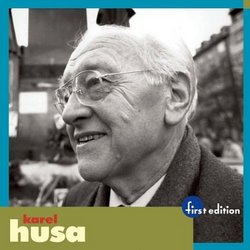| All Artists: Karel Husa, Robert Whitney, Akira Endo, Louisville Orchestra Title: Karel Husa: Two Sonnets from Michelangelo / The Trojan Women Members Wishing: 1 Total Copies: 0 Label: First Edition Release Date: 6/8/2004 Album Type: Import Genre: Classical Styles: Ballets & Dances, Ballets, Symphonies Number of Discs: 1 SwapaCD Credits: 1 UPC: 809157000235 |
Search - Karel Husa, Robert Whitney, Akira Endo :: Karel Husa: Two Sonnets from Michelangelo / The Trojan Women
 | Karel Husa, Robert Whitney, Akira Endo Karel Husa: Two Sonnets from Michelangelo / The Trojan Women Genre: Classical
|
Larger Image |
CD Details |
CD ReviewsThe Trojan Women : a significant composition in Husa's outpu Discophage | France | 02/27/2007 (4 out of 5 stars) "Karel Husa's "The Trojan Women" is a ballet written in 1980 on commission from the Louisville Orchestra and Ballet, and this CD reissues the first recording of the piece, conducted by Akira Endo in 1981, shortly after the first performance - to my knowledge, it remains the only one (the other, composer-conducted recording on a Phoenix CD - Fantasies for Orchestra/The Trojan Women - is only of the symphonic suite drawn from the ballet). The composition is viewed by Husa as the third panel in a triptych of "Manifests" (as he terms them) or outcries against the woes of mankind, also comprising his famous "Music for Prague 1968" (the Soviet block invasion of Czechoslovakia) and the 1971 "Apotheosis of this Earth" (Mankind's destruction of the planet).
The music of "The Trojan Women" is powerful and dramatic, oftentimes imaginative in its sonic invention. Among the special highlights for me are the beginning, a sinister sound-evocation in the orchestra's lower registers which could be a depiction of Chaos as in Haydn's Creation but here represents the smouldering ruins of Troy, and the transition from Prologue to scene 1 (starting at 2:25 in track 1) with its beautiful, Britten-like harp and orchestra's upward scale, ending in the strings' and harp's highest register with soft vibraphone punctuations. There is also a battle music (Scene III, track 6) which relies heavily on percussion alone and brings to mind the interlude from Music for Prague. The Epilogue is also a very dramatic build-up of tension, bringing to mind in its final pages the second movement of "Apotheosis", a violent onslaught of pounding percussion and brass interjections. On the other hand, the music's limitation, I feel, comes from its nature of "Gebrauchsmusik" (music conceived for a specific use, here the ballet): it is at times a bit too descriptive and graphic, and relies to that end on a musical vocabulary so often used as to make it sound somewhat hackneyed. Take again track 1, for instance, when Scene 1 sets in and with it Hecuba's mourning (3:49), represented by a long, sorrowful melody played on the English horn, first underpinned by harp only than a hushed "carpet" of strings, and later joined by bass clarinet. A menacing trumpet motto depicts the arrival of the Greek soldiers at 6:39 and again at 8:52 with snare drums and timpani - how more cliché can you get? Then come the mounting tension of a funeral march based on a passacaglia-like bass string ostinato (7:00), followed by a tussle between Greek soldiers and Trojan women, starting around 9:30, with string riffs pitted against woodwind shrieks - the Jets and the Sharks were there before. Not that all those musical gestures aren't dramatic and effective, but they've all been done before. To an extent they liken Husa's composition to film music - admittedly of the highest order, but not as inventive, nourishing and rewarding, in my opinion, as his more "abstract" music (his symphonies, string quartets and chamber music in general). It is something I had already remarked with "Apotheosis of this Earth" (see my review of the Louisville issue Husa, Creston and Lutoslawski), though there is more original sonic invention therein (possibly because it is less based upon a detailed plot). So, although this is a very significant composition in Husa's output and therefore indispensable to the serious collector of this composer's recordings, I wouldn't recommend it as a first introduction. For that, go to the Marco Polo release with Music for Prague, Fresque and the 2nd Symphony (see my review of Husa: Music for Prague 1968, Symphony no 2 "Reflections", Fresque). Contrary to what their title seems to imply, the Two Sonnets from Michelangelo (also a reissue of a world-premiere recording made bh Robert Whitney shortly after the first performance, in 1972) are not orchestral songs, but two short tone poems inspired by two Michelangelo sonnets: one is an eerie and haunting nocturne after by Michelangelos La Notte (the night), full of Husa's compositional trademarks (string glissandos, woodwind and string quarter-note slides, hushed harp tremolos) and rising to a powerful climax, and the other one a more agitated and anguished piece after the sculptor and poet's A Dio (To God). They are both very effective and inventive. The sound is entirely up-to-date. The notes are thorough on data about first performances and recordings (even original matrix numbers are given), the texts and translations for the two sonnets are provided, and a full synopsis of the ballet's plot is given, but there is unfortunately no info on the origins and signification of "The Trojan Women". The notes also make the claim that "Music for Prague" is available on another First Edition CD in a world premiere recording conducted by the composer - but that is wrong: that performance is conducted by Jorge Mester, and it is the disc's companion piece, "Apotheosis of this Earth", which is conducted by Husa. " |

 Track Listings (9) - Disc #1
Track Listings (9) - Disc #1